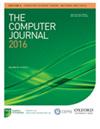一种新的基于改进树突细胞算法的入侵检测系统
IF 1.5
4区 计算机科学
Q4 COMPUTER SCIENCE, HARDWARE & ARCHITECTURE
引用次数: 0
摘要
树突细胞算法(DCA)是一种新兴的进化算法,它基于特定免疫剂的行为,即树突细胞(DC)。DCA对于二进制分类问题具有几个潜在的有益特性。在本文中,我们的目标是提供一种新版本的这种免疫启发机制作为半监督分类器,它可以作为网络入侵检测问题的防御屏障。到目前为止,在检测阶段的$Get_{Antigen()}$函数还没有采用任何策略或思想,但随机采样要求DCA每次在几个周期内提供不希望的结果。这导致了不确定性。尽管它必须通过树突状细胞在外周组织中的生物学行为来实现,但我们提出了一种新的策略,该策略完全基于树突状细胞的免疫功能。所提出的机制集中在两个方面:第一,消除了计算危险信号需要预先订购抗原集的挑战,第二,为非随机数据采样提供了一种新的免疫启发思想。还逐周期计算了可变函数迁移阈值,表明了迁移阈值灵活性的必要性。所谓的入侵检测能力(CID)的重要标准用于测试。所有测试都是在一个名为UNSW-NB15的新基准数据集中进行的。实验结果表明,作为改进的DC算法中的最佳版本,本方案的CID达到了76.69%,准确率达到了90%,并且优于其对应的方法。本文章由计算机程序翻译,如有差异,请以英文原文为准。
A New Intrusion Detection System Using the Improved Dendritic Cell Algorithm
The dendritic cell algorithm (DCA) as one of the emerging evolutionary algorithms is based on the behavior of the specific immune agents, known as dendritic cells (DCs). DCA has several potentially beneficial features for binary classification problems. In this paper, we aim at providing a new version of this immune-inspired mechanism acts as a semi-supervised classifier, which can be a defensive shield in network intrusion detection problem. Till now, no strategy or idea has been adopted on the
$Get_{Antigen()}$
function on the detection phase, but random sampling entails the DCA to provide undesirable results in several cycles at each time. This leads to uncertainty. Whereas it must be accomplished by biological behaviors of DCs in peripheral tissues, we have proposed a novel strategy that exactly acts based on its immunological functionalities of dendritic cells. The proposed mechanism focuses on two items: first, to obviate the challenge of needing to have a preordered antigen set for computing danger signal, and the second, to provide a novel immune-inspired idea for nonrandom data sampling. A variable functional migration threshold is also computed cycle by cycle that shows the necessity of the migration threshold flexibility. A significant criterion so-called capability of intrusion detection (CID) is used for tests. All the tests have been performed in a new benchmark dataset named UNSW-NB15. Experimental consequences demonstrate that the present schema as the best version among improved DC algorithms achieves 76.69% CID by 90% accuracy and outperforms its counterpart methods.
求助全文
通过发布文献求助,成功后即可免费获取论文全文。
去求助
来源期刊

Computer Journal
工程技术-计算机:软件工程
CiteScore
3.60
自引率
7.10%
发文量
164
审稿时长
4.8 months
期刊介绍:
The Computer Journal is one of the longest-established journals serving all branches of the academic computer science community. It is currently published in four sections.
 求助内容:
求助内容: 应助结果提醒方式:
应助结果提醒方式:


